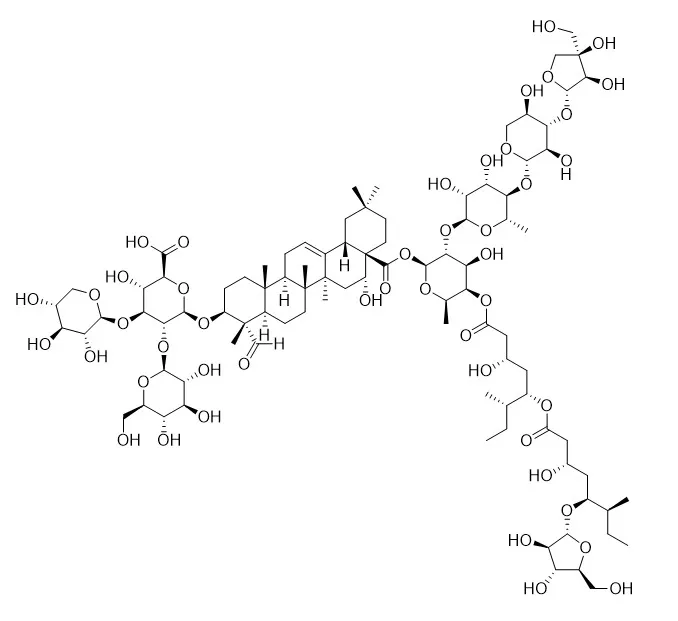| In vivo: |
| Phytomedicine . 2019 Jul;60:152905. | | Updated insights into the mechanism of action and clinical profile of the immunoadjuvant QS-21: A review[Pubmed: 31182297] | | Background: Vaccine adjuvants are compounds that significantly enhance/prolong the immune response to a co-administered antigen. The limitations of the use of aluminium salts that are unable to elicite cell responses against intracellular pathogens such as those causing malaria, tuberculosis, or AIDS, have driven the development of new alternative adjuvants such as QS-21, a triterpene saponin purified from Quillaja saponaria.
Purpose: The aim of this review is to attempt to clarify the mechanism of action of QS-21 through either receptors or signaling pathways in vitro and in vivo with special emphasis on the co-administration with other immunostimulants in new adjuvant formulations, called adjuvant systems (AS). Furthermore, the most relevant clinical applications will be presented.
Methods: A literature search covering the period 2014-2018 was performed using electronic databases from Sci finder, Science direct, Medline/Pubmed, Scopus, Google scholar.
Results: Insights into the mechanism of action of QS-21 can be summarized as follows: 1) in vivo stimulation of Th2 humoral and Th1 cell-mediated immune responses through action on antigen presenting cells (APCs) and T cells, leading to release of Th1 cytokines participating in the elimination of intracellular pathogens. 2) activation of the NLRP3 inflammasome in mouse APCs with subsequent release of caspase-1 dependent cytokines, Il-1β and Il-18, important for Th1 responses. 3) synthesis of nearly 50 QS-21 analogs, allowing structure/activity relationships and mechanistic studies. 4) unique synergy mechanism between monophosphoryl lipid A (MPL A) and QS-21, formulated in a liposome (AS01) in the early IFN-γ response, promoting vaccine immunogenicity. The second part of the review is related to phase I-III clinical trials of QS-21, mostly formulated in ASs, to evaluate efficacy, immunogenicity and safety of adjuvanted prophylactic vaccines against infectious diseases, e.g. malaria, herpes zoster, tuberculosis, AIDS and therapeutic vaccines against cancer and Alzheimer's disease.
Conclusion: The most advanced phase III clinical applications led to the development of two vaccines containing QS-21 as part of the AS, the Herpes Zoster vaccine (HZ/su) (Shingrix™) which received a license in 2017 from the FDA and a marketing authorization in the EU in 2018 and the RTS,S/AS01 vaccine (Mosquirix™) against malaria, which was approved by the EMA in 2015 for further implementation in Sub-Saharan countries for routine use. | | J Biol Chem . 2016 Jan 15;291(3):1123-1136. | | Identification of QS-21 as an Inflammasome-activating Molecular Component of Saponin Adjuvants[Pubmed: 26555265] | | Many immunostimulants act as vaccine adjuvants via activation of the innate immune system, although in many cases it is unclear which specific molecules contribute to the stimulatory activity. QS-21 is a defined, highly purified, and soluble saponin adjuvant currently used in licensed and exploratory vaccines, including vaccines against malaria, cancer, and HIV-1. However, little is known about the mechanisms of cellular activation induced by QS-21. We observed QS-21 to elicit caspase-1-dependent IL-1β and IL-18 release in antigen-presenting cells such as macrophages and dendritic cells when co-stimulated with the TLR4-agonist adjuvant monophosphoryl lipid A. Furthermore, our data suggest that the ASC-NLRP3 inflammasome is responsible for QS-21-induced IL-1β/IL-18 release. At higher concentrations, QS-21 induced macrophage and dendritic cell death in a caspase-1-, ASC-, and NLRP3-independent manner, whereas the presence of cholesterol rescued cell viability. A nanoparticulate adjuvant that contains QS-21 as part of a heterogeneous mixture of saponins also induced IL-1β in an NLRP3-dependent manner. Interestingly, despite the role NLRP3 plays for cellular activation in vitro, NLRP3-deficient mice immunized with HIV-1 gp120 and QS-21 showed significantly higher levels of Th1 and Th2 antigen-specific T cell responses and increased IgG1 and IgG2c compared with wild type controls. Thus, we have identified QS-21 as a nonparticulate single molecular saponin that activates the NLRP3 inflammasome, but this signaling pathway may contribute to decreased antigen-specific responses in vivo. | | Expert Rev Vaccines . 2011 Apr;10(4):471-486. | | Recent clinical experience with vaccines using MPL- and QS-21-containing adjuvant systems[Pubmed: 21506645] | | The immunostimulants 3-O-desacyl-4'-monophosphoryl lipid A (MPL) and the saponin QS-21 are part of licensed or candidate vaccines. MPL and QS-21 directly affect the innate immune response to orchestrate the quality and intensity of the adaptive immune response to the vaccine antigens. The combination of immunostimulants in different adjuvant formulations forms the basis of Adjuvant Systems (AS) as a way to promote appropriate protective immune responses following vaccination. MPL and aluminum salts are present in AS04, and both MPL and QS-21 are present in AS01 and AS02, which are liposome- and emulsion-based formulations, respectively. The recent clinical performance of AS01-, AS02- and AS04-adjuvanted vaccines will be discussed in the context of the diseases being targeted. The licensing of two AS04-adjuvanted vaccines and the initiation of Phase III trials with an AS01-adjuvanted vaccine demonstrate the potential to develop new or improved human vaccines that contain MPL or MPL and QS-21. |
|






 Cell. 2018 Jan 11;172(1-2):249-261.e12. doi: 10.1016/j.cell.2017.12.019.IF=36.216(2019)
Cell. 2018 Jan 11;172(1-2):249-261.e12. doi: 10.1016/j.cell.2017.12.019.IF=36.216(2019) Cell Metab. 2020 Mar 3;31(3):534-548.e5. doi: 10.1016/j.cmet.2020.01.002.IF=22.415(2019)
Cell Metab. 2020 Mar 3;31(3):534-548.e5. doi: 10.1016/j.cmet.2020.01.002.IF=22.415(2019) Mol Cell. 2017 Nov 16;68(4):673-685.e6. doi: 10.1016/j.molcel.2017.10.022.IF=14.548(2019)
Mol Cell. 2017 Nov 16;68(4):673-685.e6. doi: 10.1016/j.molcel.2017.10.022.IF=14.548(2019)